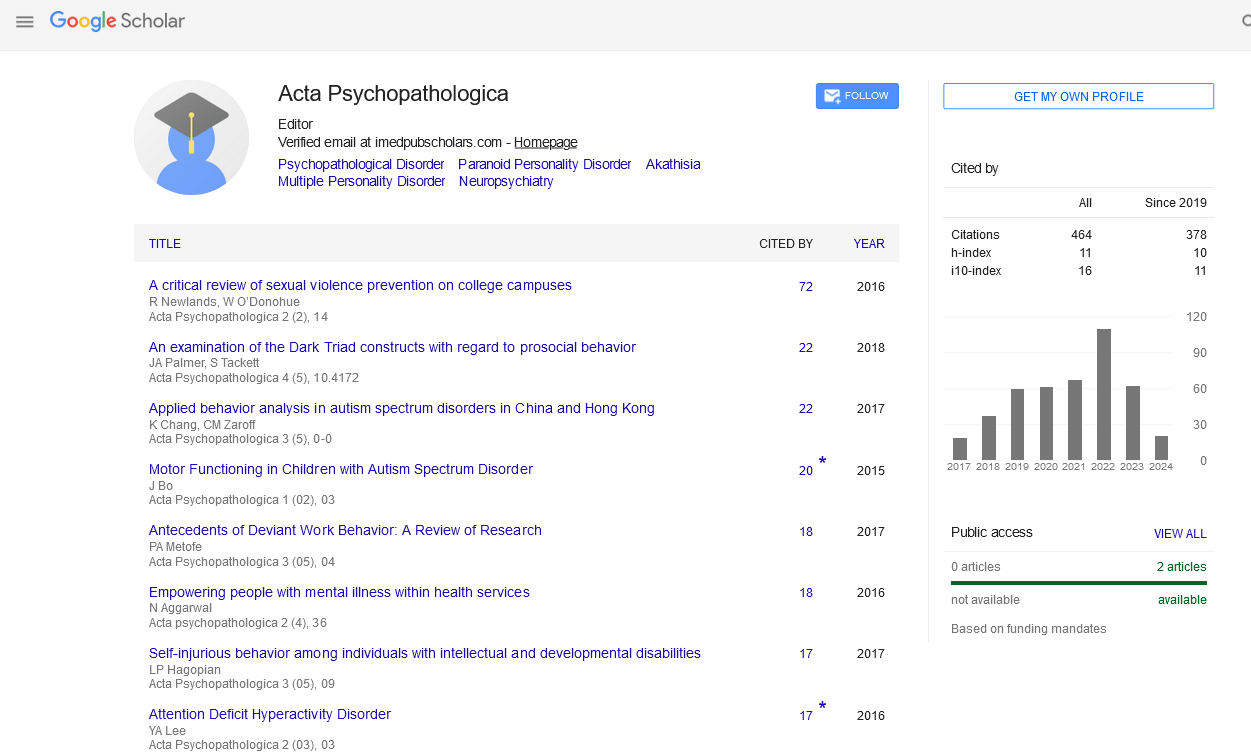Indexed In
- China National Knowledge Infrastructure (CNKI)
- CiteFactor
- Electronic Journals Library
- Directory of Research Journal Indexing (DRJI)
- OCLC- WorldCat
- Publons
- Geneva Foundation for Medical Education and Research
- Google Scholar
- SHERPA ROMEO
- Secret Search Engine Labs
- Serials Union Catalogue (SUNCAT)
Useful Links
Share This Page
Journal Flyer

Open Access Journals
- Agri and Aquaculture
- Biochemistry
- Bioinformatics & Systems Biology
- Business & Management
- Chemistry
- Clinical Sciences
- Engineering
- Food & Nutrition
- General Science
- Genetics & Molecular Biology
- Immunology & Microbiology
- Medical Sciences
- Neuroscience & Psychology
- Nursing & Health Care
- Pharmaceutical Sciences
Opinion - (2024) Volume 10, Issue 5
Unraveling Adolescent Catatonia: Pharmacologic Insights from Dual Case Studies
Stephan Gruber*Received: 01-May-2024, Manuscript No. IPAP-24-20478; Editor assigned: 03-May-2024, Pre QC No. IPAP-24-20478 (PQ); Reviewed: 17-May-2024, QC No. IPAP-24-20478; Revised: 22-May-2024, Manuscript No. IPAP-24-20478 (R); Published: 29-May-2024, DOI: 10.36648/2469-6676-10.05.41
Introduction
Adolescent catatonia is a rare but serious neuropsychiatric condition characterized by a spectrum of motor abnormalities, cognitive deficits, and behavioral disturbances. Managing catatonia in this age group requires a tailored approach that considers both the individual’s developmental stage and the complexity of their symptoms. In this dual-case series, we explore the pharmacologic management of two adolescents with catatonia, shedding light on the challenges and strategies involved in treating this condition.
Description
A 15-year-old male, referred to as John, presented with a sudden onset of mutism, immobility, and negativism. He would maintain rigid postures for extended periods, exhibiting waxy flexibility when attempts were made to move him. John’s family reported a history of mood swings and social withdrawal preceding the catatonic episode. Physical examination ruled out any underlying medical causes, confirming a diagnosis of catatonia within the context of an underlying mood disorder. The initial pharmacologic approach involved benzodiazepines, specifically lorazepam, due to their efficacy in treating catatonia. John showed a partial response with reduced rigidity and improved communication following lorazepam administration. However, his symptoms fluctuated, and he experienced breakthrough episodes of catatonia despite continued benzodiazepine therapy. Recognizing the need for a comprehensive treatment plan, John’s care team introduced second-generation antipsychotics such as risperidone. This addition targeted underlying mood instability while addressing residual catatonic symptoms. Gradually titrating risperidone alongside ongoing supportive therapy led to significant improvement in John’s overall functioning. Regular monitoring of side effects, especially metabolic parameters, was integral to ensuring the safety and efficacy of pharmacotherapy. A 16-year-old female, referred to as Sarah, presented with a history of schizophrenia spectrum disorder and recurrent catatonic episodes. Her catatonia manifested as a mix of stupor, agitation, and echolalia, posing challenges in communication and daily functioning. Sarah’s treatment history included trials of various antipsychotics and mood stabilizers, with limited success in managing her catatonic symptoms. Given the refractory nature of Sarah’s catatonia, her care team opted for electroconvulsive therapy (ECT) as an adjunctive treatment. ECT has shown promising results in addressing severe and treatment-resistant catatonia, particularly in adolescents where pharmacologic options have been exhausted. Sarah underwent a series of ECT sessions under close medical supervision, resulting in a marked reduction in catatonic features and improved engagement in therapy. Following ECT, Sarah’s medication regimen was adjusted to maintain stability and prevent relapse. Low-dose antipsychotic maintenance therapy, combined with psychoeducation and cognitive interventions, supported her recovery and functional reintegration. Regular follow-ups and monitoring of cognitive and affective domains were crucial in assessing treatment response and optimizing long-term outcomes. These cases highlight the complex nature of adolescent catatonia and the importance of individualized pharmacologic management.
Conclusion
In conclusion, navigating adolescent catatonia requires a nuanced understanding of neurodevelopmental factors, psychopathology, and treatment options. Pharmacologic interventions, including benzodiazepines, antipsychotics, and adjunctive therapies like ECT, play pivotal roles in symptom alleviation and functional recovery. Case-based insights provide valuable lessons for clinicians in optimizing care for adolescents with this challenging yet treatable condition.
Citation: Gruber S (2024) Unraveling Adolescent Catatonia: Pharmacologic Insights from Dual Case Studies. Act Psycho. 10:41.
Copyright: © 2024 Gruber S. This is an open-access article distributed under the terms of the Creative Commons Attribution License, which permits unrestricted use, distribution, and reproduction in any medium, provided the original author and SOURCE are credited.

